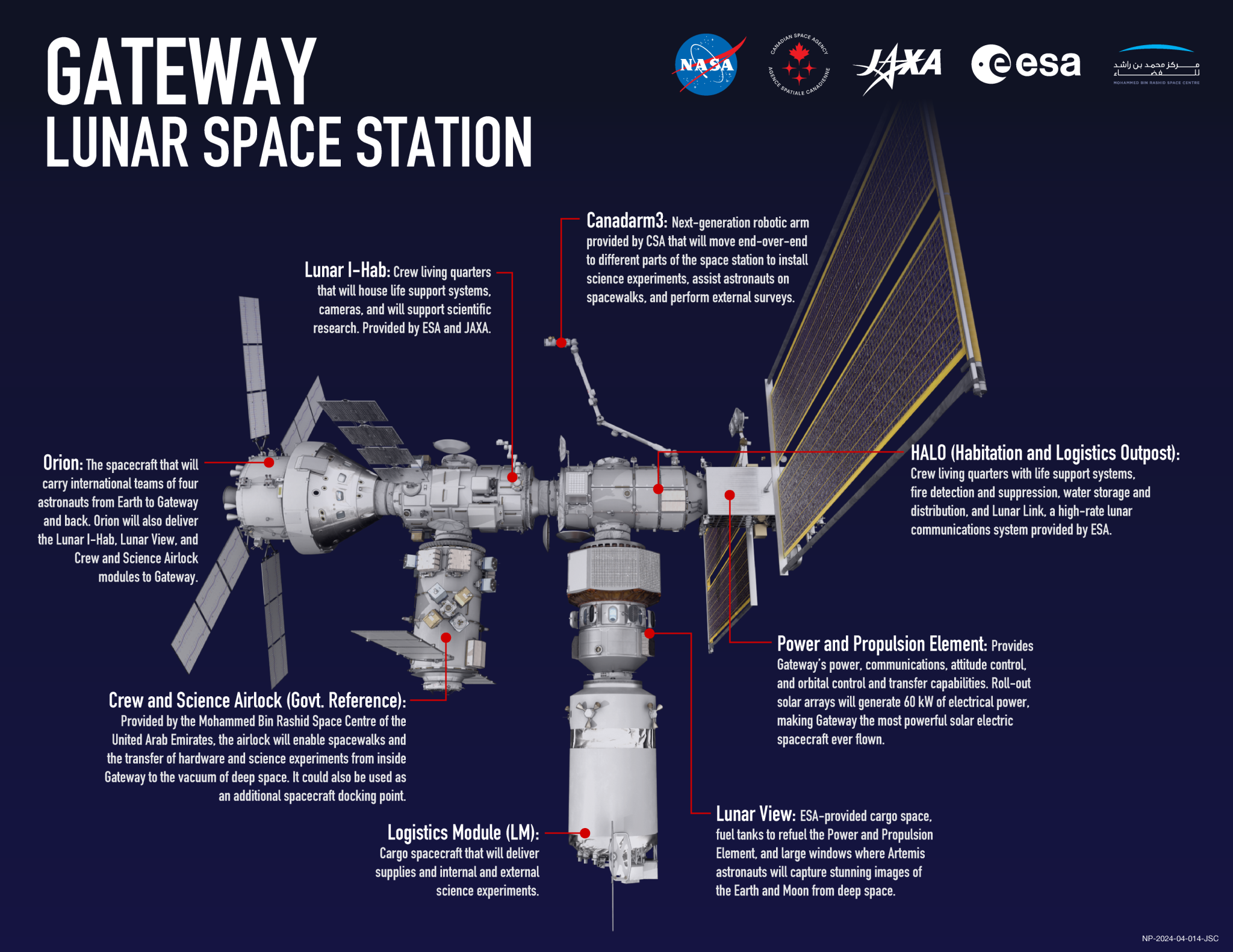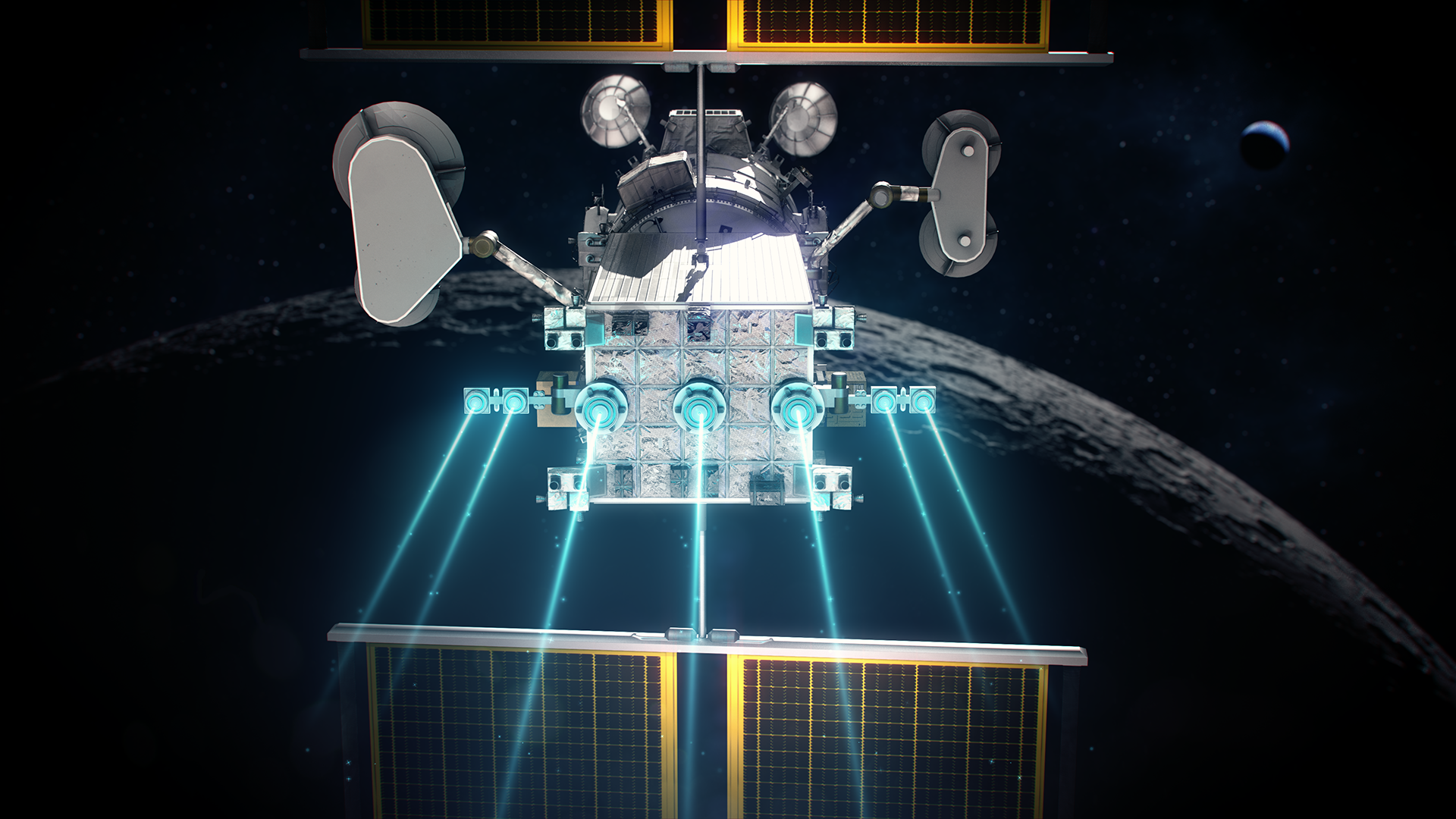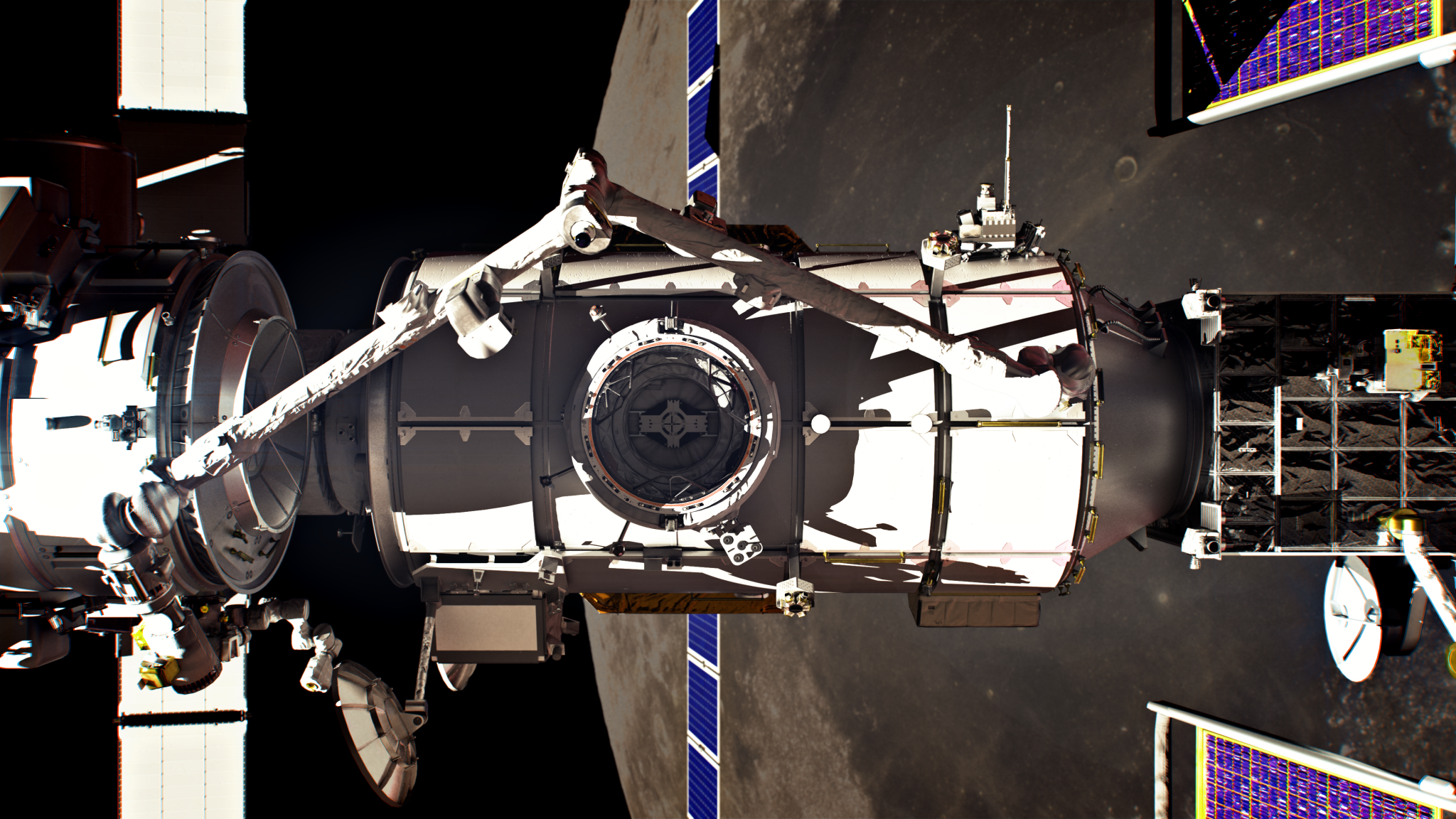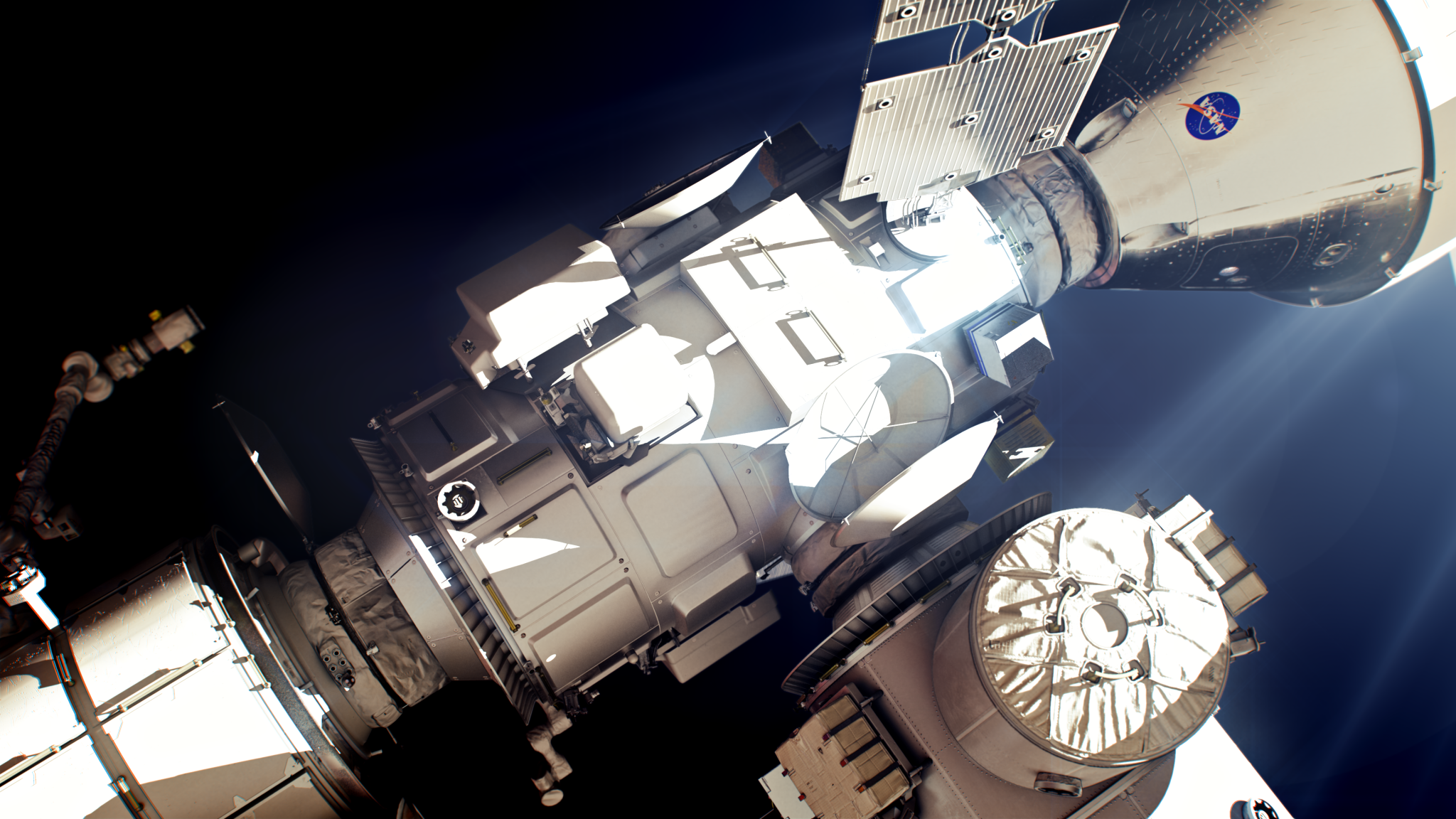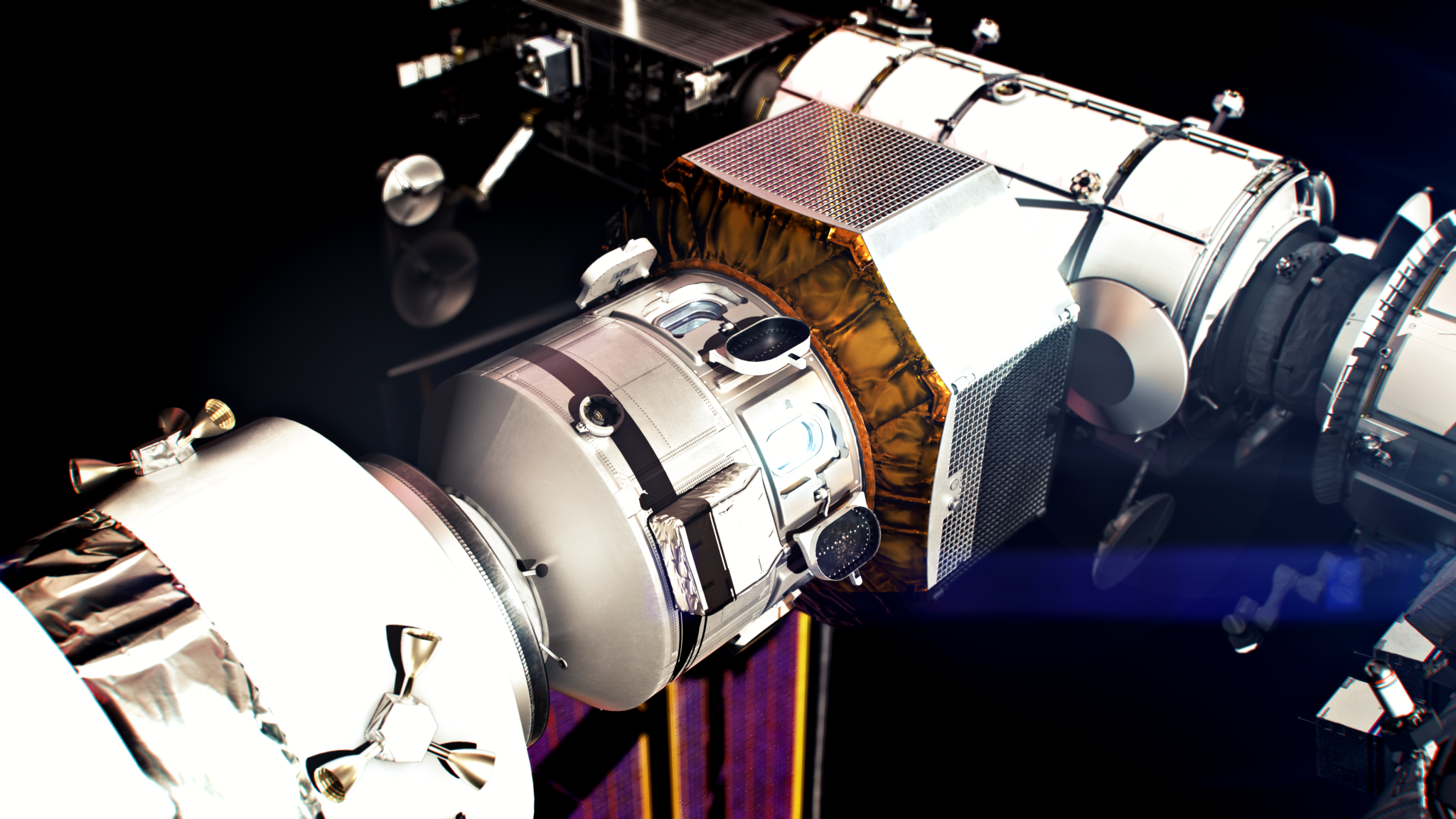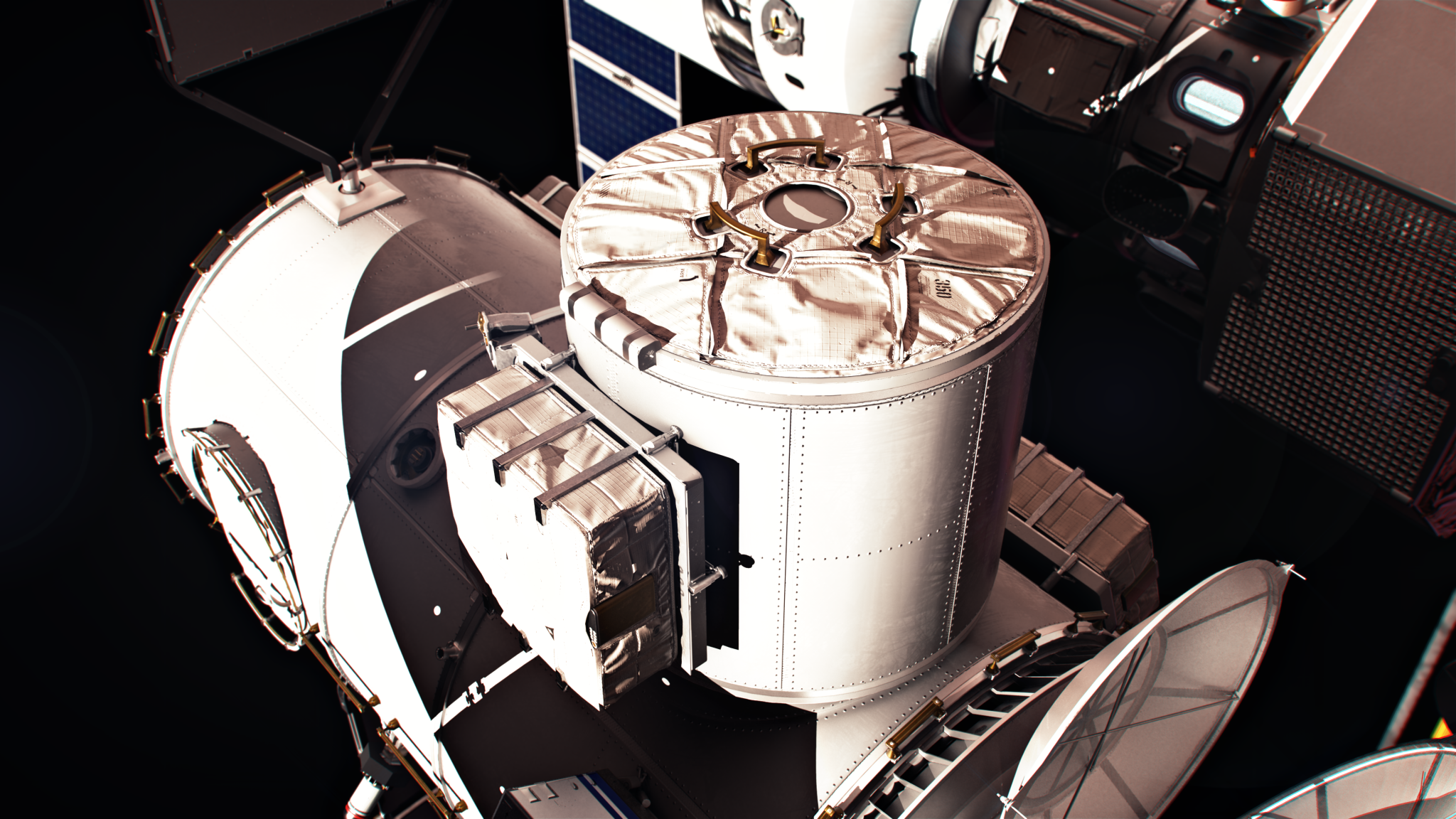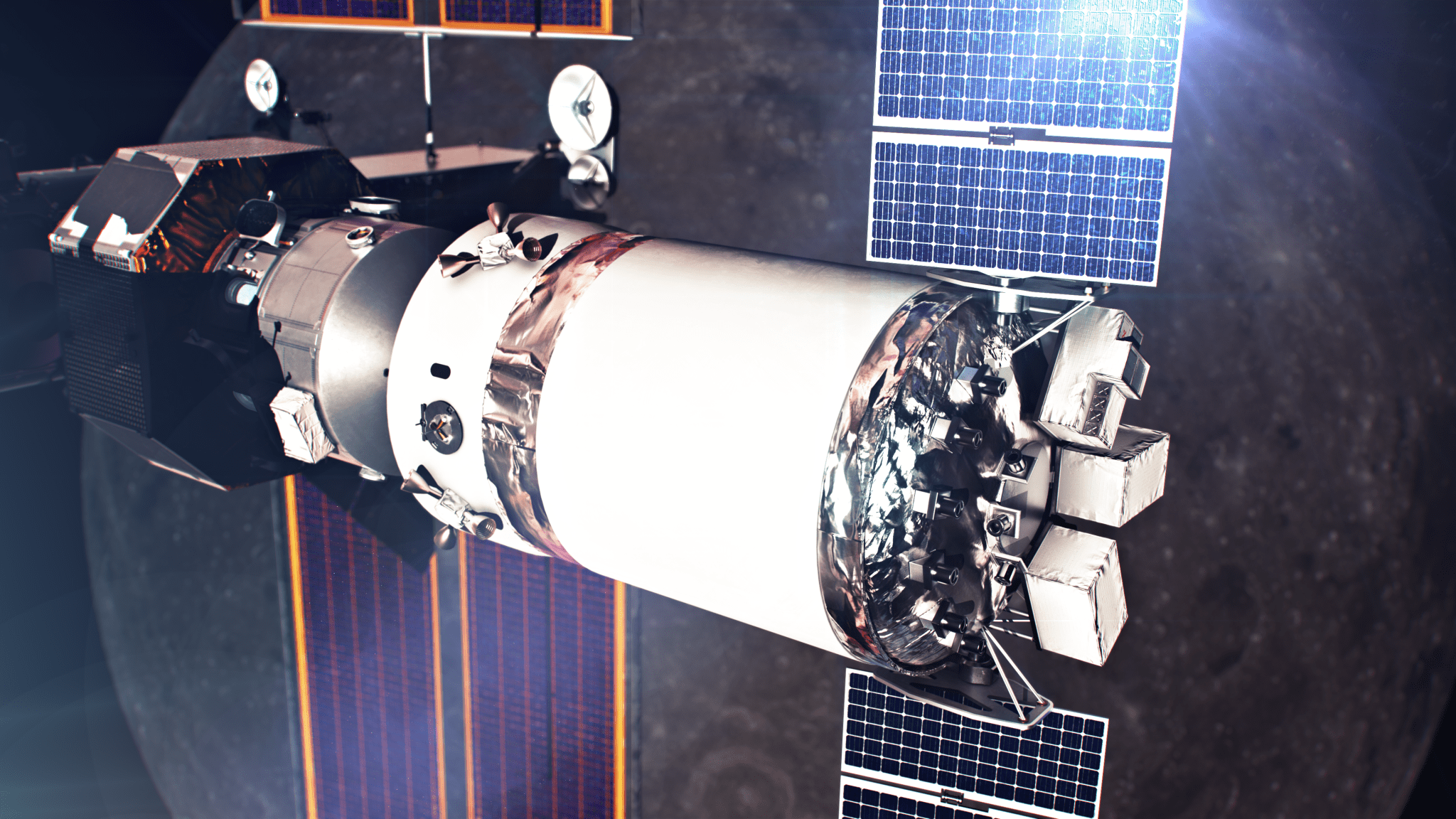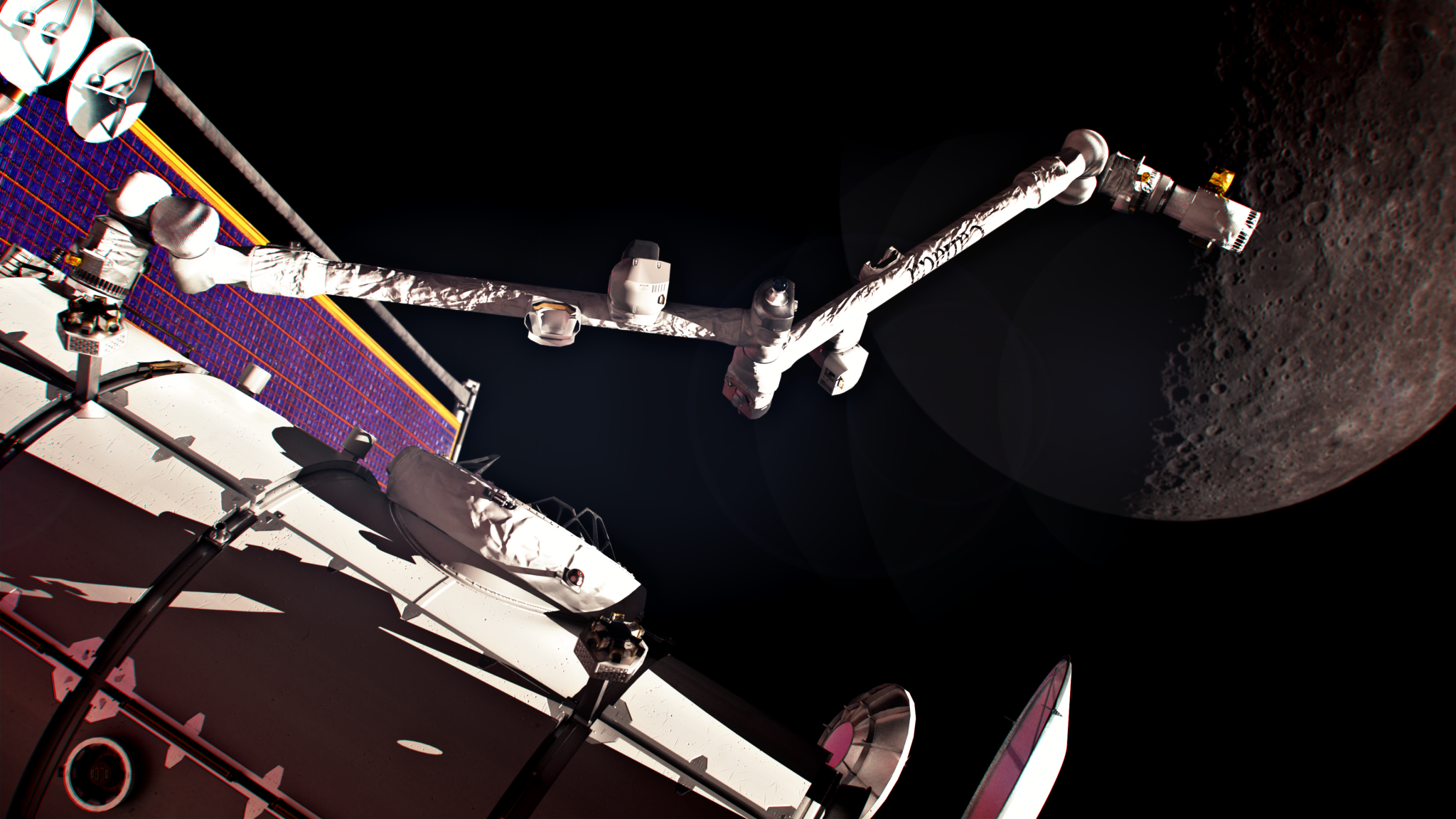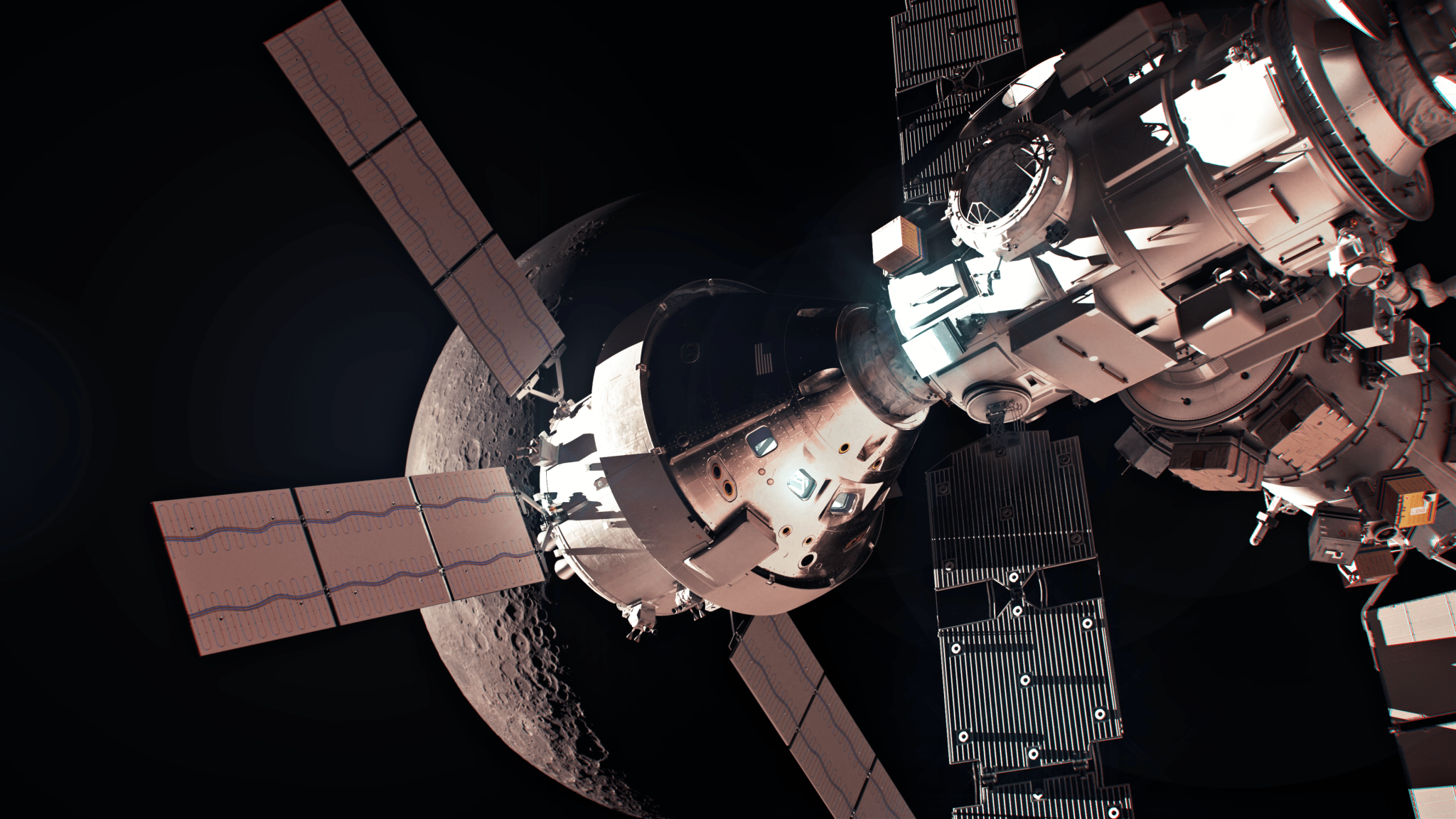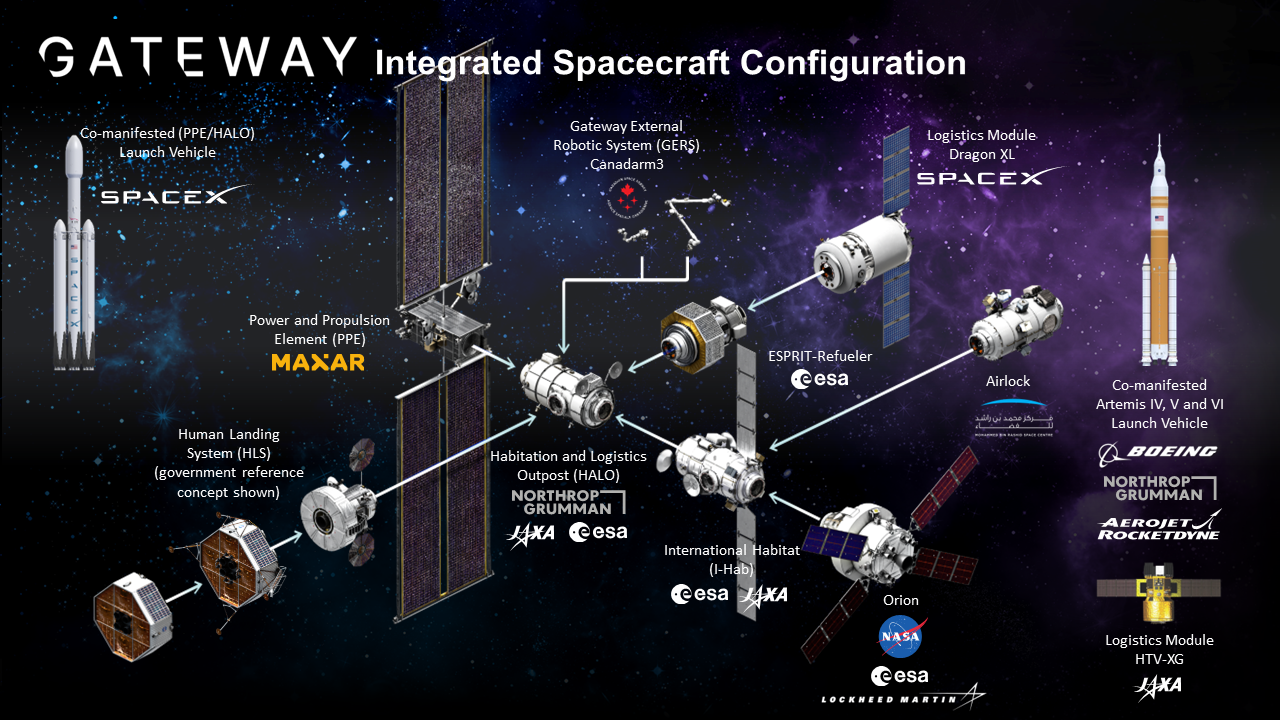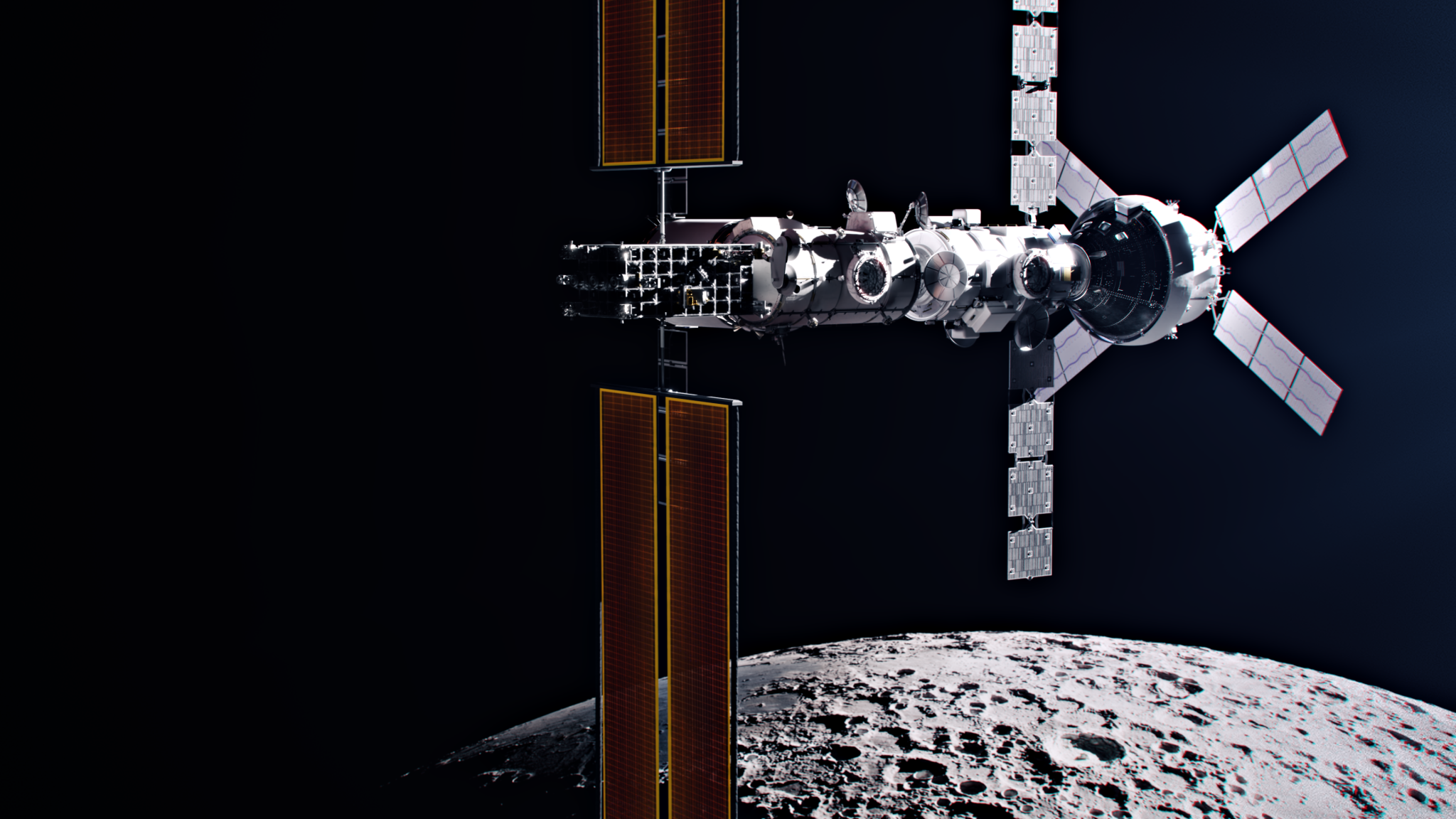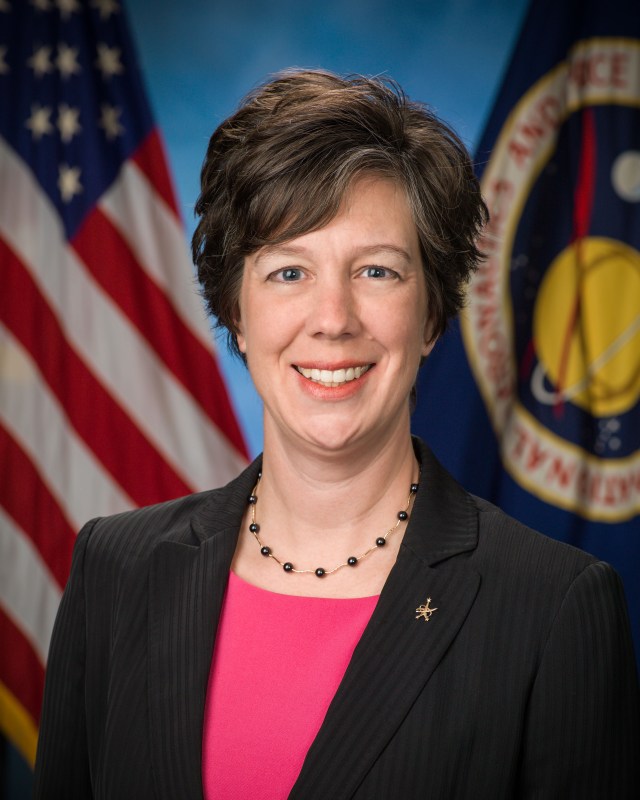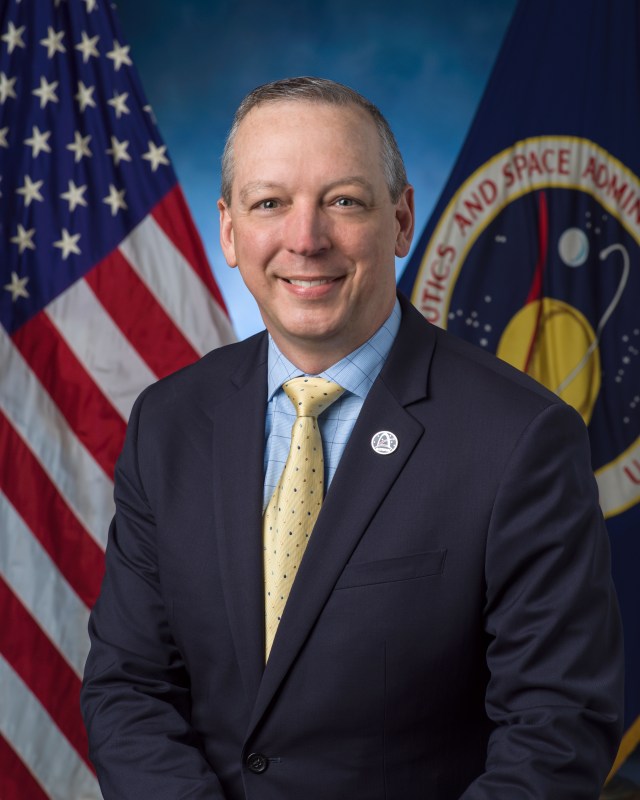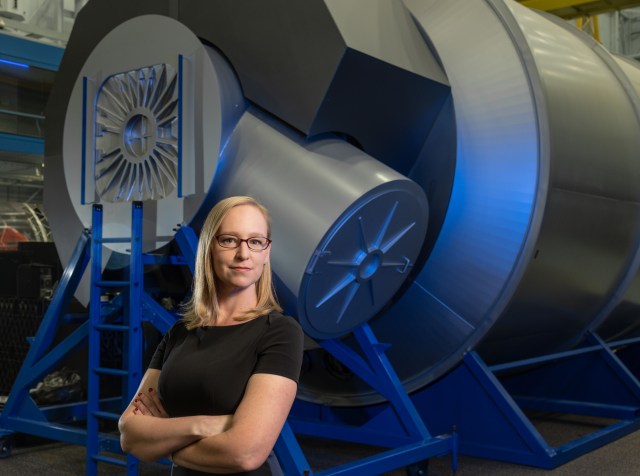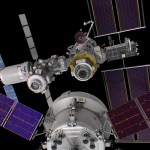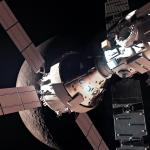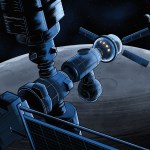Gateway Space Station
The NASA-led Gateway Program is an international collaboration to establish humanity's first space station around the Moon as a vital component of the Artemis campaign. Gateway will help NASA and its partners test the technologies and capabilities required for a sustained human presence in deep space, and chart a path for the first human missions to Mars.
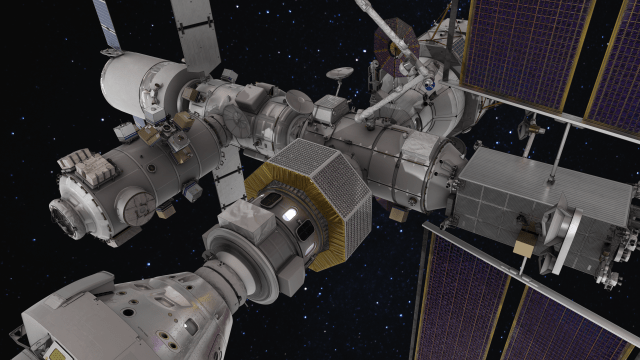
Overview
A NASA-led international coalition, Gateway will be a space station in lunar orbit enabling long-term human exploration at the Moon and new opportunities for scientific discovery as a foundational system to support NASA’s Artemis campaign.
Gateway is essential to the Artemis architecture, along with the Space Launch System, Orion spacecraft, Human Landing System, and spacesuits that will enable extensive exploration of the Moon’s South Pole.
International Partners
Gateway is a centerpiece of the United States’ efforts through Artemis to engage international partners to advance exploration of deep space and on to Mars. While NASA is leading the Artemis missions, international partnerships will play a key role in achieving a sustainable and robust presence on and around the Moon.
Space agencies making significant contributions to Gateway:
- The Canadian Space Agency (CSA) is providing the next-generation external Canadarm3 robotic arm and advanced robotic interfaces to host payloads and provide base points on Gateway.
- ESA (European Space Agency) is providing:
- the Lunar I-Hab, one of two habitation elements where Artemis crew will live, conduct research, and prepare for lunar surface activities.
- the Lunar View module that will provide refueling for PPE, cargo logistics and windows for Moon, Earth and deep space viewing.
- Lunar Link to enable high-data-rate communications between the lunar surface and Gateway.
- The Japan Aerospace Exploration Agency (JAXA) is providing:
- critical components of the Lunar I-Hab module that will provide the heart of the space station’s life support capabilities. Japan will provide Lunar I-Hab’s Environmental Control and Life Support System (ECLSS), thermal control system functions, and cameras.
- batteries to power HALO, Lunar I-Hab, and Lunar View.
- HTV-XG spacecraft for launch and delivery of a logistics resupply mission for Gateway.
- The Mohammed Bin Rashid Space Centre of the United Arab Emirates will provide Gateway’s Crew and Science Airlock that will permit crew and science transfers to and from the vacuum of space.
Astronauts from Canada, Europe, Japan, and the United Arab Emirates will fly on Artemis missions to Gateway.
Gateway Elements
With its modular design offering flexibility and extensibility over its minimum 15-year lifespan in lunar orbit, Gateway offers a building block approach to deep space exploration and development.
Power and Propulsion Element (PPE)
The Power and Propulsion Element is a high-power, 60-kilowatt solar electric propulsion spacecraft that will provide power, high-rate communications between Gateway and Earth, attitude control, and orbital transfer capabilities for Gateway.
In May 2019, NASA selected Maxar Technologies of Westminster, Colorado, to develop and build PPE.
The PPE project is managed out of NASA’s Glenn Research Center in Cleveland, Ohio.
HALO (Habitation and Logistics Outpost)
HALO is one of two habitation elements where astronauts will live, exercise, prepare meals, rest, prepare for lunar surface missions, and conduct research while visiting Gateway. The pressurized living quarters will provide docking ports for visiting spacecraft like NASA’s Orion spacecraft, lunar landers, and logistics resupply craft, and serve as the backbone for command and control and power distribution across Gateway. The module will perform other core functions, including hosting science investigations via internal and external payload accommodations, and communicating with lunar surface expeditions through the Lunar Link system provided by ESA.
HALO is managed out of NASA’s Johnson Space Center in Houston. Northrop Grumman of Dulles, Virginia was awarded a contract for the preliminary design of HALO in 2020, and the remaining content for HALO was finalized between NASA and Northrop Grumman through signing a contract in July 2021.
Lunar I-Hab
Gateway second habitable element, Lunar I-Hab is a pressurized module that will provide living quarters for astronauts visiting the Gateway, and multiple docking ports for visiting vehicles and other modules.
Lunar I-Hab is led by ESA, which selected Thales Alenia Space as prime contractor. JAXA is making significant contributions to Lunar I-Hab, providing the environmental control support system, thermal cooling pumps, and batteries.
Lunar View
Provided by ESA, Lunar View is a habitable element that will transport cargo to Gateway, provide storage space once docked at the space station, provide fuel to Gateway’s propulsion system, and provide a view of space and the Moon through its windows.
The prime contractor for Lunar View is Thales Alenia Space.
Crew and Science Airlock
Provided by the Mohammed Bin Rashid Space Centre of the United Arab Emirates, the Crew and Science Airlock will be a critical piece of infrastructure for Gateway’s planned minimum 15-year lifespan in lunar orbit, permitting crew and science payload transfers to and from the habitable environment of Gateway’s crew modules to the vacuum of space – transfers that will be essential for space station maintenance and conducting science in the deep space lunar environment.
As astronauts conduct missions at Gateway and prepare for lunar surface expeditions, they will need deliveries of critical pressurized and unpressurized cargo, science experiments, and supplies like sample collection materials. In March 2020, NASA announced SpaceX as the first U.S. commercial provider under the Gateway Logistics Services contract to deliver cargo and other supplies to Gateway.
The Gateway Deep Space Logistics Office is based at NASA’s Kennedy Space Center in Florida.
Canadarm3
Part of the Gateway External Robotics Systems (GERS) provided by CSA, Canadarm3 is a robotic system that will use cutting-edge software to perform Gateway tasks. The system will help maintain, repair and inspect Gateway, capture visiting vehicles, help astronauts during spacewalks, and enable science in Gateway’s lunar orbit.
Vehicle System Manager (VSM) software will allow Gateway to operate autonomously, representing a leap forward in spacecraft capability. VSM will provide activity planning, resource management, vehicle control, and fault management for Gateway.
Additional Artemis elements not managed under the Gateway Program:
- The Orion spacecraft will deliver crew and supplies to the Gateway space station.
- Human Landing System spacecraft will dock to Gateway to enable Artemis crew transit to and from the lunar surface.
Science Destination
The Gateway space station is one of humanity’s next science utilization platforms, offering unique opportunities to leverage the deep space lunar environment for scientific research and discovery.
The three science instrument payloads already selected to fly on Gateway will focus on radiation from the Sun and deep space. They are:
- the Heliophysics Environmental and Radiation Measurement Experiment Suite (HERMES) that will fly on the outside of HALO.
- the European Radiation Sensors Array (ERSA) that will fly on the outside of PPE.
- the Internal Dosimeter Array (IDA) that will fly inside of HALO.
Gateway Assembly
Gateway launch and staging
The first Gateway elements, PPE and HALO, will launch together to lunar orbit on a SpaceX Falcon Heavy rocket no earlier than 2025.
Gateway will spend one year transiting to its unique polar orbit, known as near-rectilinear halo orbit (NRHO), around the Moon.
Artemis IV, V, and VI assembly missions
On-orbit assembly of the fully realized Gateway space station will commence with the Artemis IV mission that will launch no earlier than September 2028.
Artemis IV
Artemis astronauts will enter Gateway for the first time on the Artemis IV mission.
Primary objectives of the mission are to integrate Lunar I-Hab with Gateway and complete the second crewed lunar surface expedition of the Artemis missions.
Mission highlights:
- The crewed Orion spacecraft and Lunar I-Hab Gateway element will launch as a co-manifested payload on an SLS Block 1B rocket to lunar orbit.
- Orion will deliver Lunar I-Hab to Gateway, where it will dock to HALO.
- A Human Landing System spacecraft will dock to Gateway.
- Artemis IV crew members will use the Human Landing System to descend to and later ascend from the lunar surface.
- Artemis IV crew will return to Earth on Orion.
Artemis V
Primary objectives of the mission are to integrate Lunar View with Gateway and complete the third crewed lunar surface expedition of the Artemis missions.
Mission highlights:
- The crewed Orion spacecraft and the Lunar View element will launch as a co-manifested payload on an SLS Block 1B rocket to lunar orbit.
- Orion will deliver Lunar View to Gateway, where it will dock to HALO.
- A Human Landing System spacecraft will dock to Gateway.
- Artemis V crew members will use the Human Landing System to descend to and later ascend from the lunar surface.
- Artemis V crew will return to Earth on Orion.
Artemis VI
Primary objectives of the mission are to integrate the Crew and Science Airlock with Gateway and complete the fourth crewed lunar surface expedition of the Artemis missions.
Mission highlights:
- The crewed Orion spacecraft and Gateway’s Crew and Science Airlock will launch as a co-manifested payload on an SLS Block 1B rocket to lunar orbit.
- Orion will deliver the Crew and Science Airlock to Gateway, where it will dock to Lunar I-Hab.
- A Human Landing System spacecraft will dock to Gateway.
- Artemis VI crew members will use the Human Landing System to descend to and later ascend from the lunar surface.
- Artemis VI crew will return to Earth on Orion.
Leadership
Program History
Gateway is making significant progress toward launch of the initial components to lunar orbit. NASA is reviewing the schedule for launch, previously planned for October 2025, to provide additional development time and better align that launch with the Artemis IV mission in 2028.
2024
- January 2024, NASA and the Mohammed Bin Rashid Space Centre (MBRSC) of the United Arab Emirates announced that under a new implementing arrangement, the UAE will provide Gateway’s Crew and Science Airlock module, and a UAE astronaut to fly to the lunar space station on a future Artemis mission.
2023
- March 2023, NASA establishes the Moon to Mars Program Office at NASA headquarters to carry out the agency’s human exploration activities at the Moon and Mars for the benefit of humanity.
- March 2023, Dr. Jon B. Olansen named Gateway Program Manager.
- March 2023, Dan Hartman retires from NASA with 29 years of service to human spaceflight, including the International Space Station Program and serving as the first Gateway Program Manager.
- January 2023, Gateway participated in the Artemis Architecture Concept Review , a robust analysis process designed to align NASA’s Moon to Mars exploration strategy and codify the supporting architecture.
2022
- December 2022, Northrop Grumman delivers high-fidelity HALO module mockup to the Space Vehicle Mockup Facility at Johnson Space Center for human factors testing and crew training.
- December 2022, second Gateway Multilateral Coordination Board meeting held.
- November 2022, NASA and JAXA announce that under the Gateway Implementing Arrangement, NASA will provide an opportunity for a Japan Aerospace Exploration Agency (JAXA) astronaut to serve as a Gateway crew member on a future Artemis mission.
- August 2022, HALO critical design review held.
- May 2022, Holly Ridings, NASA’s first female Chief Flight Director, named Deputy Program Manager.
2021
- December 2021, PPE Maxar Preliminary Design Review part two.
- November 2021, Lunar I-Hab Preliminary Design Review part two close-out.
- July 2021, Northrop Grumman extension awarded.
- May 2021, HALO preliminary design review close out.
- May 2021, first Gateway Multilateral Coordination Board meeting held, modeled after International Space Station Multilateral Coordination Board.
- April 2021, 6KW SEP subsystem test by PPE team, Maxar, and Busek.
- March 2021, Delivery of first Flight SolAero Standard Solar Power Modules (SPM).
- February 2021, HALO primary structure assembly initiated in Italy.
2020
- December 2020, Japan signed an agreement (MOU) to partner with NASA on Gateway.
- December 2020, the Canadian Space Agency awarded a contract to MDA to build the Canadarm3 for deep space missions.
- November 2020, Canada signed a Gateway agreement (MOU) to contribute external robotics.
- October 2020, ESA signed an agreement (MOU) with NASA to contribute habitation and refueling modules and enhanced lunar communications to Gateway. ESA also provides two additional European Service Modules for NASA’s Orion spacecraft.
- Northrop Grumman Space received award to design the Habitation and Logistics Outpost (HALO) for Gateway
- NASA selected SpaceX as the first U.S. commercial provider under the Gateway Logistics Services contract to deliver cargo, experiments and other supplies to Gateway.
2019
- November 2019, the European Space Agency (ESA) received authorization and funding to support its contributions to Gateway including habitation and refueling.
- October 2019, Japan announced plans to join the United States on Gateway with contributions of habitation components and logistics resupply.
- May 2019, NASA selected Maxar Technologies to develop, build, and support an in-space demonstration of the element.
- February 2019, Canada announced intention to participate in Gateway and contribute advanced external robotics.
- Gateway Program Established



























